Highlights from our 15th year of working to protect Maui’s reefs
Founded in 2007, Maui Nui Marine Resource Council (MNMRC) is a nonprofit organization working for healthy coral reefs, clean ocean water, and abundant native fish for the islands of Maui County (Maui Nui).
Maui Nui Marine Resource Council has much to be thankful for as we look back over our 2022 accomplishments. We celebrated 15 years of working with our community partners to protect Maui’s nearshore environment. Thanks to generous donors and grant funding, we added new program areas, moved projects toward completion, and much more. Below are some highlights from the past year.
Download the full .pdf report with additional details here.
Reef Friendly Landscaping
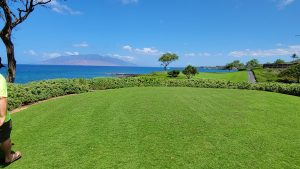
Success at one of the RFL test plots.
Our Reef Friendly Landscaping (RFL) is made up of three programs that include our test plot program, RFL certification program for private properties, and collaboration, education, and outreach.
The liquid biological soil amendment, aka SoilThrive, test plot program worked with seven community partners: the County of Maui Parks and Recreation; Wailea Community Association; Mākena Golf and Beach Club, Kamaole Sands, Four Seasons Resort, and Maluaka Beach to allow these properties to trial organic method on their properties. Funding from HTA and MVCB will add eleven additional test sites in 2023.
The RFL certification recognizes properties that are transitioning to organic landscaping practices. Three properties were finalizing the certification process at the end of 2022.
Mauka to Makai : Ungulate Fencing
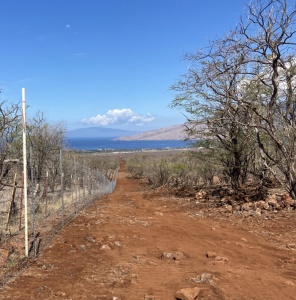
MNMRC worked with Kaonoulu Ranch to have 8 ft tall ungulate fencing installed running mauka to makai. This is in addition to extensive fencing efforts that the ranch and other partners are working to install. Every little or big bit helps. This area is adjacent to gulches that flow sediment and nutrients to the ocean when it rains.
Fencing is paired with the harvest of the invasive axis deer from within the perimeters. The fencing helps control deer herd movements to preferred areas and makes harvesting easier. This combined effort will reduce erosion and allow grasses to regrow and stabilize the soil. An added bonus is that fire breaks can be made at the same time as the fencing is installed.
Mauka to Makai : Pohakea and Ma’alaea
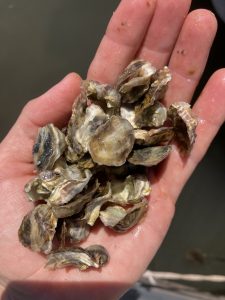
Juvenile oysters filter sediment from the waters of Ma’alaea Harbor
In early 2022 we completed our vetiver planting project in Pohakea, adding this drought-resistant grass to erosion-prone areas to mitigate sediment flow into Maalaea Bay during heavy rain. On the makai side, our oyster bioremediation project is helping to clean the water in the bay. Three-thousand juvenile oysters were added in late 2022. Adult oysters filter up to 50 gallons each day.
Our oysters come from UH Hilo’s Pacific Aquaculture and Coastal Resource Center and are bred as triploid to prohibit them from reproducing and instead focus on growing big and filtering lots of water, and also ensures they don’t pose any threat to native species.
Sunscreen Ban Effects
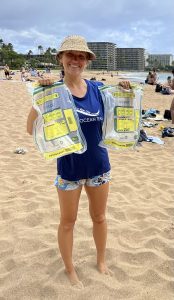
MNMRC Program Manager, Meredith Beeson, testing for environmental sunscreen residue on Maui’s Beaches
Maui’s ban on non-mineral sunscreen took effect on October 1, 2022. We are working with Dr. Craig Downs to determine the effectiveness of this ban. We took water samples from 5 Maui beaches in September before the ban went into effect, and we will do the same in 2023 to compare sunscreen chemical levels before and after the ban.
If we see a decrease in the banned chemicals, we will know this type of legislation is effective, and if not, MNMRC and its partners will know that more public outreach is needed to decrease these contamination levels and protect our coral reef ecosystems.
Community-based Water Quality Testing: Hui O Ka Wai Ola
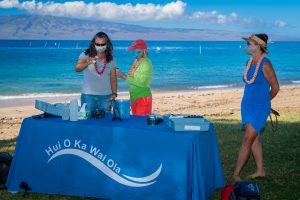
This year marked the sixth year of Hui O Ka Wai Ola as a community-based water quality monitoring program that was launched and conducted by MNMRC, The Nature Conservancy, and West Maui Ridge to Reefs Initiative in partnership with the State of Hawaii Department of Health Clean Water Branch. “The Hui” tests the water to inform the state, county, and community about coastal water quality.
The well-trained community volunteers test physical parameters including temperature, salinity, pH, dissolved oxygen, and turbidity in a mobile lab on site. They also prepare samples that are analyzed by the SOEST Lab for Analytical Biogeochemistry at UH Mānoa for organic and inorganic nutrients such as Total Nitrogen, Nitrates, Nitrites, Total Phosphorus, Phosphate, Silicate, and Ammonia.
Aqualink : Realtime Oceanographic Data
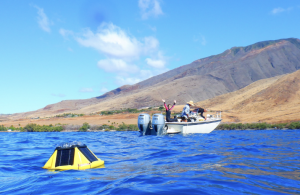
AquaLink buoy in the foreground at Olowalu.
We have deployed three Aqualink buoys in the ocean near Kalama Park in Kula Kai (Kihei), Ma’alaea Bay, and Olowalu. These satellite-linked buoys record ocean temperatures just below the surface and also at the same depth as most of our corals. We can watch this real-time data and know if there is a threat of a bleaching event.
Along with temperature, they also measure wind direction and speed and wave height, direction, and frequency at the surface. Best of all, this live data is available to the public anytime, at https:aqualink.org. We encourage all our water-user partners to take advantage of these condition reports.
Outreach and Education
MNMRC educated visitors about marine life and conservation with the County of Maui’s help. Travelers were met with ads as they first arrived on the island at the Kahului Airport. Terminal window signs shared information about reef health, snorkel tips, and sunscreen use. In baggage claim, four short videos encouraged visitors to respect the ocean while they waited for their luggage.
The ads feature reef-friendly messaging including Stand only on sand, Coral is alive – Keep fins up Coral is Alive- Keep your Paddle Up, Mineral only sunscreen, Wear a rashguard – Use less Sunscreen, Protecting Coral Reefs, Welcome to Maui – Enjoy wildlife from a distance. The ads were also heavily promoted on Spectrum TV and our Facebook and Instagram.
Financial Statement
Over the past year, MNMRC again demonstrated our ability to provide the greatest impact for coral reefs with every dollar raised. In 2022, we spent 79% of our income on program services. According to CharityWatch, a charity organization devoting 75% of its income to program services is considered “highly efficient.” We are proud to have exceeded this standard which would qualify us for a CharityWatch rating of “Excellent.” View the .pdf report for details.
Looking forward to 2023
This coming year will see the continuation of many of our longer-term projects such as Reef Friendly Landscaping, ungulate fencing to reduce erosion and sediment pollution, and, of course, Hui O Ka Wai Ola will continue to keep you informed about water quality. New efforts include the start of coral reef monitoring along South Maui from Kīhei to Mākena, the growth of Reef Friendly Landscaping to include homeowners, and increased efforts to address flooding in Kīhei.
We continue to appreciate and rely on the support of our donors who allow us to engage in the work to support clean water, abundant fish, and healthy coral reefs on Maui. Thank you for supporting us last year and please consider continuing to support MNMRC in 2023.




No Comments
Sorry, the comment form is closed at this time.